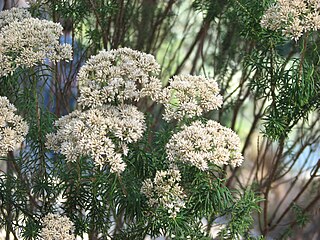
Cassinia aculeata, commonly known as common cassinia, dolly bush or dogwood , is a species of flowering plant in the family Asteraceae and is endemic to south-eastern Australia. It is an erect shrub with sessile, linear, variably-sized leaves, and heads of creamy-white to white flowers arranged in rounded cymes.

Cassinia arcuata, commonly known as drooping cassinia, biddy bush, Chinese scrub, sifton bush and Chinese shrub, is a species of flowering plant in the family Asteraceae and is endemic to Australia. It is a shrub, sometimes a small tree with sessile, linear leaves, and heads of up to two hundred brownish flowers arranged in pyramid-shaped panicles. In New South Wales, the species is known as Cassinia sifton. In disturbed areas, C. arcuata can become weedy.

Cassinia tenuifolia, commonly known as bully bush or killmoke, is a species of flowering plant in the family Asteraceae and is endemic to Lord Howe Island. It is a dense, bushy shrub with hairy young stems, crowded linear leaves and sweetly scented flower heads arranged in corymbs.

Cassinia laevis, commonly known as cough bush, dead finish, curry bush or rosemary bush, is a species of flowering plant in the family Asteraceae and is endemic to south-eastern continental Australia. It is a shrub with a curry-like odour, crowded linear leaves, and heads of creamy-white flowers arranged in panicles.

Cassinia compacta is a species of flowering plant in the family Asteraceae and is endemic to eastern Australia. It is a shrub with densely hairy stems, linear leaves and heads of yellow flowers arranged in dense corymbs.

Cassinia leptocephala is a species of flowering plant in the family Asteraceae and is endemic to New South Wales. It is a large, woody shrub with hairy, reddish stems, stiff linear leaves, and heads of pale yellow flowers arranged in a dense corymb.

Cassinia uncata, commonly known as sticky cassinia, is a species of flowering plant in the family Asteraceae and is native to inland New South Wales and the south-east of South Australia. It is an erect shrub with hairy young stems, narrow linear to needle-shaped leaves, and heads of off-white to cream-coloured flowers arranged in rounded, almost conical panicles.
Cassinia copensis is a species of flowering plant in the family Asteraceae and is endemic to eastern Australia. It is an erect, multi-stemmed shrub with aromatic, cylindrical leaves, and heads of creamy-white flowers arranged in a flattened corymb.
Cassinia decipiens is a species of flowering plant in the family Asteraceae and is endemic central New South Wales. It is a shrub with woolly-hairy young twigs, spreading, cylindrical leaves, and heads of creamy-brown to yellowish flowers arranged in a rounded cyme.
Cassinia furtiva is a species of flowering plant in the family Asteraceae and is endemic to a restricted area of New South Wales. It is a shrub with hairy, sticky stems, narrow linear leaves and 100 to 150 flower heads arranged in a rounded dichasium.
Cassinia hewsoniae is a species of flowering plant in the family Asteraceae and is native to New South Wales and the Australian Capital Territory. It is an erect shrub with a sticky, densely-hairy stems, needle-shaped leaves and flower heads arranged in flat or rounded corymbs.

Cassinia macrocephala is a species of flowering plant in the family Asteraceae and is endemic to northern New South Wales. It is a shrub with narrow linear leaves and spherical, white to cream-coloured or yellowish-green heads.
Cassinia monticola commonly known as mountain cassinia, is a species of flowering plant in the family Asteraceae and is endemic to mountain areas of south-eastern Australia. It is a spreading shrub with sticky, narrow linear to narrow lance-shaped leaves, and bronze-coloured to greenish-cream heads of flowers arranged in a dense, round-topped corymb.
Cassinia ochracea is a species of flowering plant in the family Asteraceae and is endemic to south-eastern New South Wales. It is an erect or spreading shrub with hairy stems, needle-shaped leaves and flat or rounded corymbs of up to four hundred flower heads.
Cassinia telfordii is a species of flowering plant in the family Asteraceae and is endemic to eastern Australia. It is an erect shrub with hairy young stems, linear leaves and corymbs of up to several hundred yellow to cream-coloured flower heads.
Cassinia straminea is a species of flowering plant in the family Asteraceae and is endemic to eastern Australia. It is an erect shrub with hairy young stems, linear leaves and corymbs of up to several hundred flower heads.
Cassinia theresae is a species of flowering plant in the family Asteraceae and is endemic to central New South Wales. It is an erect shrub with hairy young stems, needle-shaped leaves with flared bases, and corymbs of up to fifty flower heads.

Cassinia lepschii is a species of flowering plant in the family Asteraceae and is endemic to eastern Australia. It is an erect or spreading shrub with densely hairy young stems, needle-shaped leaves and flower heads arranged in flat or rounded corymbs.
Cassinia heleniae is a species of flowering plant in the family Asteraceae and is endemic to a small area in northern New South Wales. It is a shrub with a few sticky stems, sticky needle-shaped leaves and flower heads arranged in a rounded to flat-topped cyme.
Cassinia thinicola is a species of flowering plant in the family Asteraceae and is endemic to coastal New South Wales. It is a compact shrub with hairy young stems, needle-shaped to slightly flattened leaves, and corymbs of up to 150 flower heads.










